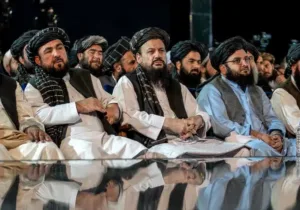America’s war in Afghanistan has deteriorated into a never-ending skirmish to keep the Taliban, al Qaida, ISIS, and their allies under pressure across South Asia. The American soldier is the proverbial Dutch boy with his finger in the dam, keeping the deluge at bay at the price of his own freedom. Despite perennial naysaying, this is an acceptable and even successful strategy for coping with the threat of transnational jihadist terrorism—so long as policymakers understand that “success” does not mean military victory or an end to the conflict in Afghanistan. It means, rather, preventing the Taliban from taking control of Afghanistan through indefinite support to Afghan security forces and never-ending counterterrorism operations.
In fact, this “finger-in-the-dam” strategy is the best available option given America’s de facto preference to enjoy relative freedom from jihadist violence without the expense of solving the root problems from which jihadism springs. This style of frontier warfare is the price America pays for regional order on the cheap. But such a strategy comes with hidden, steep costs in public opinion, on military readiness, and in alliance relationships. Whether the United States can afford the illusory savings of order on the cheap is another question—one that the war in Afghanistan may ultimately answer.
The Real Afghanistan Strategy
Among the most widely repeated criticism of the war in Afghanistan is that the United States does not have a strategy, that it has unclear or unachievable goals, and that it lacks an exit strategy. That the war has ground on for 17 years without easily identifiable progress is, for these critics, proof enough. “I’ve been hearing this nonsense about Afghanistan for 17 years with no success,” Trump reportedly told his National Security Council early in his term, according to Bob Woodward’s account. Trump thought, “We’ve got a bunch of inconsistent, short-term strategies. We can’t continue with the same old strategy.” Trump was deeply concerned to have an exit strategy, a guaranteed way to end America’s involvement in the war.
Trump’s criticism—widely echoed by scholars and analysts—misses the mark, and his announcement to reduce US ground presence by half will not solve the problem. The problem is not that the United States has lacked a goal or a strategy. It is that there has been a sharp disconnect between the United States’ declarative policy and its actual policy choices. There has been a persistent gap between the U.S.’s publicly declared goals, which have often been far-reaching and ambitious, and the revealed preference of its policymakers to do only what is minimally required to stave off immediate or catastrophic defeat. The result is a constant sense of failure and a persistent lack of progress towards long-term goals.
President George W. Bush spoke grandly about his desire to spread democracy and rebuild nations, but in practice, he adopted a “light footprint” approach and tried to outsource state-building efforts to the United Nations. After the emergence of the Taliban insurgency in late 2005 and early 2006, Bush began to shift towards a counterinsurgency strategy, but his simultaneous move in Iraq starved the Afghan mission of needed resources. Bush was not alone in this tendency. President Barack Obama initially embraced and dramatically expanded the counterinsurgency strategy and shrunk the gap between rhetoric and policy—but undercut himself by announcing a withdrawal deadline in advance and (a widely underreported part of Obama’s failure) never following through with adequate funds for civilian reconstruction. I tried and failed, to persuade both presidents to change course as director for Afghanistan and Pakistan on the National Security Council staff in both administrations.
Another way of putting it is that the United States has pursued two different goals across two different time frames and with two different sets of tools. The U.S.’s long-term goal is, ostensibly, a secure, stable, democratic Afghanistan capable of defending itself and its borders and denying terrorist safe haven with its own security forces. But the United States has pursued this goal mostly by offering encouraging rhetoric, talking about (but never fully committing to) a counterinsurgency campaign, intermittently attempting peace talks with the Taliban, and signing a series of agreements, including the 2005 and 2012 Strategic Partnership Agreements and the 2013 Bilateral Security Agreement. It has also invested a substantial amount of time and money into training and equipping the Afghan Army, but overall progress towards long-term goals has been halting and incomplete, though not a total failure. The worst failure has been the international community’s comprehensive unwillingness to invest in enough capacity building to strengthen the institutions of the Afghan government.
At the same time, the U.S.’s actual policy choices as reflected in its budgetary and deployment decisions—what might be called its de facto strategy or revealed preference—shows a different set of goals and priorities. American policymakers in the Bush and Obama administrations consistently implemented a different strategy than they have claimed. The implemented strategy has prioritized killing and capturing jihadist militants—including those from al-Qaida, Taliban, the Haqqani Network, Hezb-i Islami, the Pakistani Taliban, and now the Islamic State—while investing just enough in counterinsurgency and stability operations to preserve operational freedom for American counterterrorism forces. It would be much harder to target jihadists if Afghanistan were in a state of civil war or chaos, much less back under Taliban control.
These two different goals are not necessarily in conflict. They could be the short-term and long-term components of an overarching, comprehensive approach if both were embraced and given adequate resources—something that the United States came close to achieving between 2007 and 2011. Unfortunately, in practice, the two approaches compete for resources, attention, and public support, given the high cost of sustaining both, and they tend to confuse the public—and the rotating cast of policymakers over a 17-year effort—about what America and its allies are actually trying to achieve. The Obama administration effectively gave up on the long-term approach after its first year in office when the president balked at its high cost, though some of his programs and policies limped along for a few more years through bureaucratic inertia.
Worse, the two approaches sometimes work at cross purposes, as when U.S. military operations undermine Afghans faith in their government, fuel resentment, or erode support for American counterterrorism operations. And policymakers’ persistent prioritization of short-term goals has a self-defeating quality: the United States has perfected the art of killing and capturing jihadist militants while enjoying less success in preventing their radicalization in the first place, ensuring the war will never end. The net effect of all of America’s efforts in Afghanistan is vastly less than the sum of its parts.
Whose Victory?
Commentators have been declaring failure in Afghanistan for almost as long as the U.S. has been waging war there. In truth, the U.S. has never missed an opportunity to make a mistake, and yet it has somehow managed not to lose. Instead of losing, the American soldier is trapped waging a never-ending frontier conflict on the furthest edges of the international system. This is not a sign of failure: it is what U.S. policymakers have deliberately chosen because they will neither accept defeat nor pay the price of a more ambitious campaign to resolve the conflict. American strategy aims to sustain an indefinite counterterrorism presence in South Asia to kill or capture militant leaders while avoiding a Taliban takeover in Afghanistan. By that standard, the policy is a complete success and is indefinitely sustainable.
In fact, the war in Afghanistan may be a model of conflicts to come. The United States is notorious for wanting the benefits of the liberal international order on the cheap, at least in the post-Cold War era. So long as the leading state in the international system continues to underfund its tools of civilian power, including its diplomatic corps, aid and development budget, information operations, and public diplomacy, there is no reason to expect that it will be able to bring any conflict to a sustainable political solution.
Political solutions are, after all, the essential condition for ending political violence, and they require expertise, diplomacy, and negotiation, all of which are in short supply in Washington, D.C. Managing endless frontier warfare is the price the United States pays for its unwillingness or inability to adopt and fund long-term, comprehensive politico-military strategies that address immediate security threats while redressing underlying conditions that enable political violence in the first place. This will be as true in a hypothetical postwar occupation of North Korea or Syria as it is in Afghanistan, Yemen, or the tribal areas of Pakistan.
But this short-term model of warfare carriers some significant costs. Such wars, as we see with the war in Afghanistan, eventually become unpopular with the American people. While the public is initially attracted to the apparent realism and thrift of surgical counterterrorism operations, they tire of decades-long war and come to believe (rightly) that the savings are illusory. Such wars are also unpopular within the military. The longer such wars drag on, the greater the impact they will have on morale, recruitment, retention, and unit cohesion, to say nothing of their impact on veteran’s health care costs and on the post-conflict transition to civilian life.
More abstractly, perpetual wartime footing is bad for the body politic. “Any long war always entails great hazards to liberty in a democracy … [War] must invariably and immeasurably increase the powers of civil government,” Alexis de Tocqueville argued. “All those who seek to destroy the freedom of the democratic nations must know that war is the surest and the shortest means to accomplish this.” While there are strong reasons to support the growth of the United States’ global intelligence and security apparatus, observers are not paranoid to fear how such tools might be someday misused.
Finally, there is the steep cost the United States pays in the blow to its reputation, its relationships around the world, and to its moral self-image. Few observers at home or abroad are heartened or inspired by the image of the United States waging endless war in an impoverished, shattered nation with little to show for it except for a fresh round of killed or captured militants and, regrettably, civilian casualties caught in the crossfire. Similarly, the war has strained the relationships among between the United States and its longest and most trusted allies, frustrated by uneven burden sharing and, at times, unclear or competing strategies. And the war has not helped the relationship between the American and the Afghan people.
Remembering the Afghan people should remind us that the steepest cost of American’s longest war has not fallen on the United States. The American public and U.S. policymakers should at least be honest about the cost to the Afghans of waging an indefinite war in their country with no intention of stopping or helping them address the root causes of perennial political violence there, at least some of which was deliberately stoked, used, and orchestrated by the United States for its own ends during the Cold War. In past generations, Americans prided themselves on being a force for good in the world, an aspirational nation founded on universal principles of equality and freedom. It is increasingly difficult to square that self-image with a nation and a government that has chosen a strategy of endless war because it can’t be bothered to take the alternative—a strategy actually aimed at winning—seriously.
Dr. Paul D. Miller is a professor of international affairs at Georgetown University, a senior fellow at the Atlantic Council, and a veteran of the war in Afghanistan. He served as Director for Afghanistan and Pakistan on the National Security Council staff for Presidents George W. Bush and Barack Obama. He is the author of American Power and Liberal Order: A Conservative Internationalist Grand Strategy.






